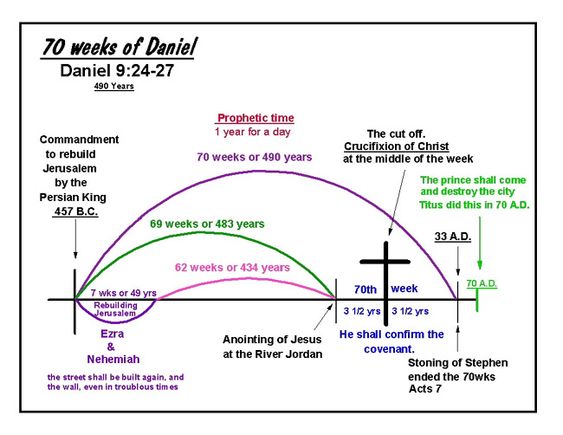In the Seventh-day Adventist interpretation of the Prophecy of Seventy Weeks in Daniel chapter 9, the 490 years is an uninterrupted period starting from "the time the word goes out to rebuild and restore Jerusalem," of Daniel 9:25 and ending 3½ years after Jesus' death. The starting point identified with a decree by Artaxerxes I in 458/7 BCE to provide money to rebuild Jerusalem and its temple. Now there where two earlier decrees by Cyrus and Darius’. So why don't these two decrees qualify to start the prophecy of Daniel 9:25? Well lets take a look at these two decrees. The first is the decree of Cyrus, given in his first year (probably 537/536 B.C.) which is recorded in Ezra 1:1-4. An undated decree of Darius (but falling about his second year, 520/519 B.C.) which is found in Ezra 6:1-12 merely reconfirms the decree of Cyrus. however, the first two decrees are about the temple, and its reconstruction, whereas the statement in Daniel 9:25 is concerned with the decree that resulted in the rebuilding of the city of Jerusalem. The first two decrees can be omitted from consideration, because they deal only with the building of the temple, and not the rebuilding of the city and restoration, "that from the going forth of the commandment to restore and to build Jerusalem unto the Messiah the Prince shall be seven weeks, and threescore and two weeks: the street shall be built again, and the wall, even in troublous times." So we can see that the third decree of Artaxerxes is the one that started the prophecy of Daniel 9 and was implemented in September/October 457 B.C
The appearance of "Messiah the Prince" at the end of the 69 weeks (483 years) is aligned with Jesus' baptism in 27 CE. The 'cutting off' of the "anointed one" is applied to the Jesus' execution 3½ years after the end of the 483 years, bringing "atonement for iniquity" and "everlasting righteousness". Jesus' death is said to 'confirm' the "covenant" between God and mankind by in 31 CE "in the midst of" the last seven years. The end of the 70th week is associated with 34 CE when the gospel was redirected from only the Jews to all peoples
Christian historicism, which is what unveils these verses from scripture, interprets prophecy as an overview of the history of the Christian church, asserting connections between historical events and statements in the Bible, and distinguishing between prophecies considered already fulfilled and those still to come. The Jews of biblical times, had taught this view in the many prophecies to be fulfilled, which were pointing to the Messiah such as those by the prophets Isaiah and Ezekiel. The early church and the precursors to the Reformation used it, Jerome in his 'Commentary on Daniel' went into the kingdoms that Daniel predicted. Many Protestant Reformers were interested in historicism and the day-year principle, and used it assigning prophecies in the Bible to past, present and future events. It was prevalent in Wycliffe's writings and taught by Martin Luther, John Calvin, John Wesley, and Sir Isaac Newton and many others.[ George Whitefield, Charles Finney, C. H. Spurgeon, Matthew Henry, Adam Clarke, Albert Barnes, and Bishop Thomas Newton also are considered as advocates of this view. Modern proponents of historicism include historian Edward Bishop Elliott, theologian Francis Nigel Lee, and denominations in derived the 19th century Millerite movement, including Seventh-day Adventists.
The appearance of "Messiah the Prince" at the end of the 69 weeks (483 years) is aligned with Jesus' baptism in 27 CE. The 'cutting off' of the "anointed one" is applied to the Jesus' execution 3½ years after the end of the 483 years, bringing "atonement for iniquity" and "everlasting righteousness". Jesus' death is said to 'confirm' the "covenant" between God and mankind by in 31 CE "in the midst of" the last seven years. The end of the 70th week is associated with 34 CE when the gospel was redirected from only the Jews to all peoples
Christian historicism, which is what unveils these verses from scripture, interprets prophecy as an overview of the history of the Christian church, asserting connections between historical events and statements in the Bible, and distinguishing between prophecies considered already fulfilled and those still to come. The Jews of biblical times, had taught this view in the many prophecies to be fulfilled, which were pointing to the Messiah such as those by the prophets Isaiah and Ezekiel. The early church and the precursors to the Reformation used it, Jerome in his 'Commentary on Daniel' went into the kingdoms that Daniel predicted. Many Protestant Reformers were interested in historicism and the day-year principle, and used it assigning prophecies in the Bible to past, present and future events. It was prevalent in Wycliffe's writings and taught by Martin Luther, John Calvin, John Wesley, and Sir Isaac Newton and many others.[ George Whitefield, Charles Finney, C. H. Spurgeon, Matthew Henry, Adam Clarke, Albert Barnes, and Bishop Thomas Newton also are considered as advocates of this view. Modern proponents of historicism include historian Edward Bishop Elliott, theologian Francis Nigel Lee, and denominations in derived the 19th century Millerite movement, including Seventh-day Adventists.
Last edited:



